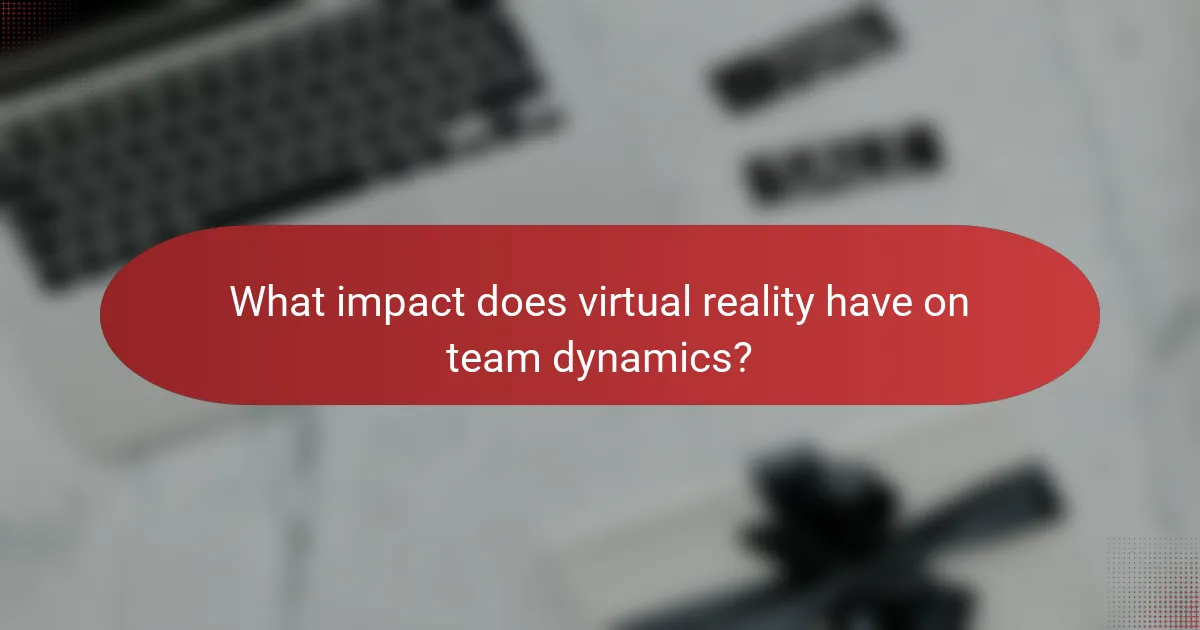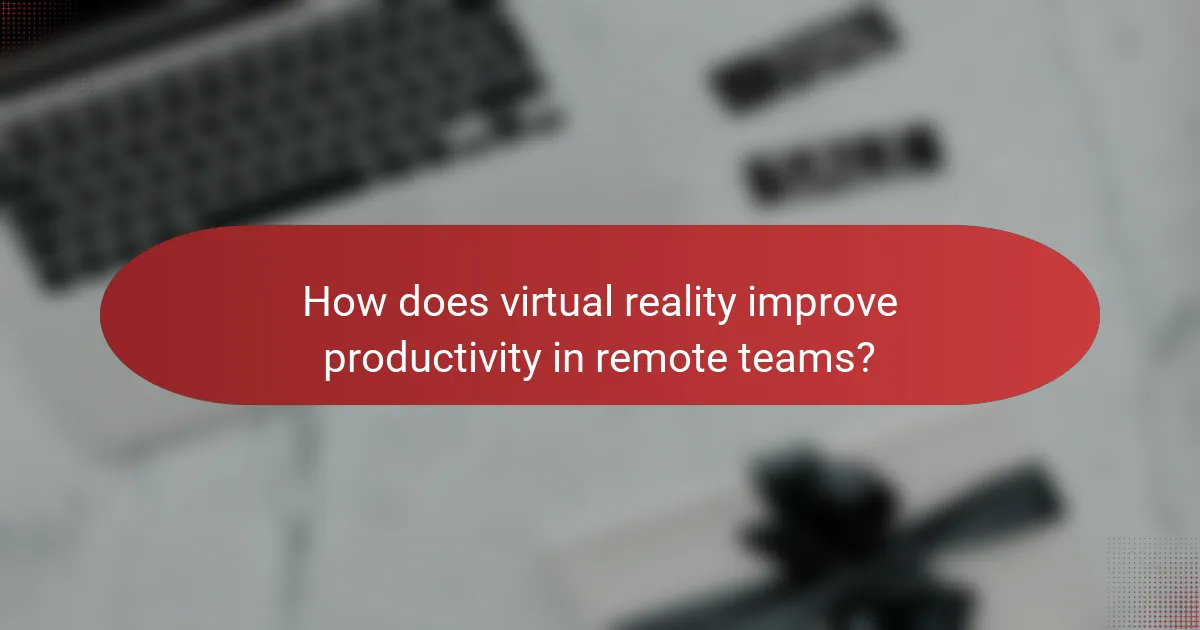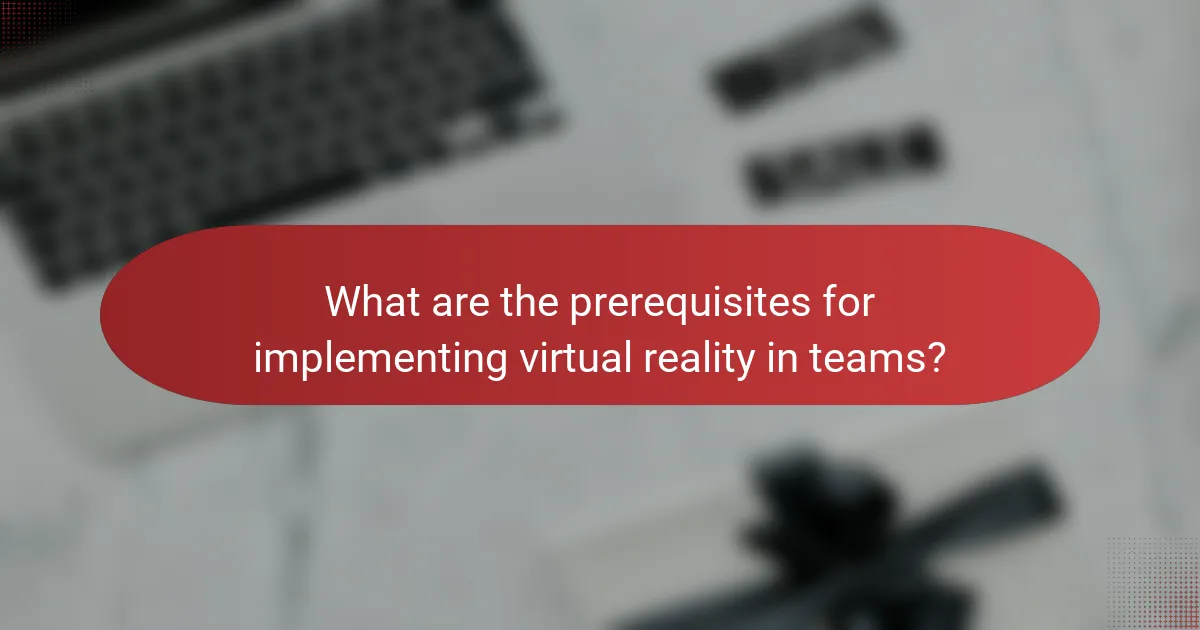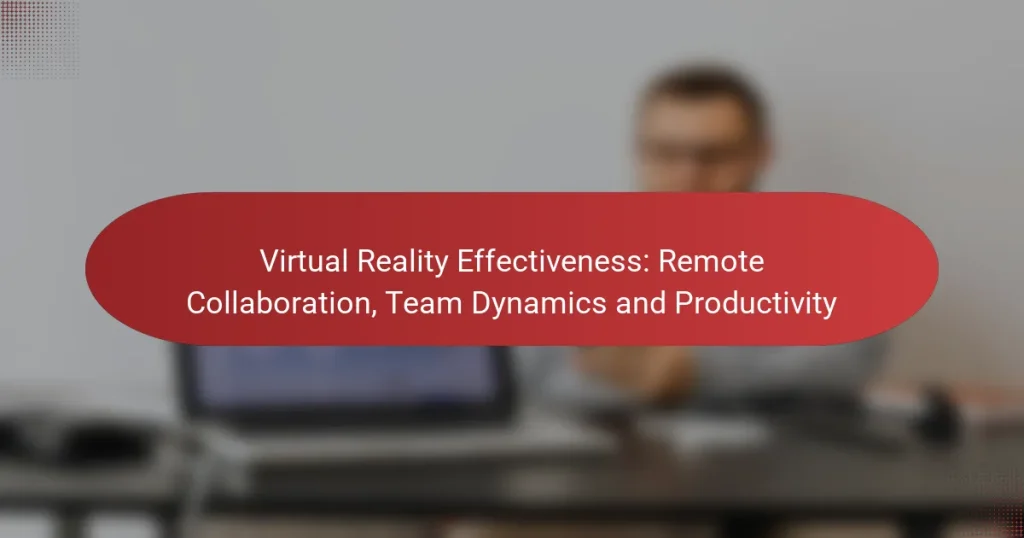Virtual reality (VR) is transforming remote collaboration by providing immersive environments that enhance interaction and engagement among team members. This innovative technology not only improves communication but also fosters stronger team dynamics and boosts productivity, allowing individuals to connect and collaborate effectively regardless of their physical locations.

How does virtual reality enhance remote collaboration in the UK?
Virtual reality (VR) significantly enhances remote collaboration in the UK by creating immersive environments that facilitate interaction and engagement among team members. This technology allows users to communicate more effectively, participate in realistic simulations, and feel more connected despite geographical distances.
Improved communication tools
VR offers advanced communication tools that surpass traditional video conferencing. Features like spatial audio and 3D avatars allow participants to interact as if they were in the same room, making conversations more natural and intuitive. This can lead to better understanding and fewer miscommunications.
Incorporating VR platforms can streamline team discussions and decision-making processes, as users can share ideas and feedback in real-time within a shared virtual space.
Realistic meeting environments
Virtual reality creates realistic meeting environments that mimic physical spaces, enhancing the overall experience of remote collaboration. Users can enter virtual boardrooms or creative studios, which can help set the right tone for meetings and foster creativity.
These environments can be customized to reflect a company’s branding, making meetings feel more professional and aligned with corporate culture, which is particularly beneficial for UK-based businesses.
Increased engagement levels
Engagement levels in virtual meetings can be significantly higher when using VR. Participants are more likely to stay focused and actively contribute when immersed in a virtual setting, as the interactive elements keep their attention. This is especially important for lengthy discussions or brainstorming sessions.
To maximize engagement, companies should encourage all team members to use VR headsets and participate actively, as this fosters a sense of presence and involvement.
Enhanced visual presentations
VR enhances visual presentations by allowing users to interact with 3D models and data visualizations. This immersive experience can make complex information easier to understand and more impactful. For example, a marketing team can showcase a new product in a virtual showroom, allowing stakeholders to explore it from all angles.
Utilizing VR for presentations can lead to better retention of information, as participants can visualize concepts rather than just hearing about them.
Access to global talent
Virtual reality breaks down geographical barriers, providing access to global talent without the need for travel. UK companies can collaborate with experts from around the world, enhancing their teams with diverse skills and perspectives. This is particularly advantageous in sectors like technology and design, where specialized knowledge is crucial.
To leverage this global talent pool, businesses should invest in VR tools that facilitate seamless collaboration and ensure all team members are comfortable using the technology.

What impact does virtual reality have on team dynamics?
Virtual reality (VR) significantly enhances team dynamics by creating immersive environments that foster collaboration and communication. It allows team members to interact in ways that traditional tools cannot, leading to improved relationships and productivity.
Strengthened interpersonal relationships
VR enables team members to engage in shared experiences, which can strengthen interpersonal relationships. By participating in virtual team-building activities or collaborative projects, individuals can develop a sense of camaraderie that may be lacking in remote settings.
For example, virtual escape rooms or team challenges can promote bonding and trust, making it easier for team members to connect on a personal level. This connection can lead to a more cohesive team culture, which is essential for effective collaboration.
Increased trust among team members
Trust is a critical component of successful teams, and VR can enhance this by providing a platform for transparent communication. Through immersive interactions, team members can better understand each other’s perspectives and capabilities, fostering a sense of reliability.
Regular VR meetings can help establish norms and expectations, allowing team members to feel more secure in their roles. As trust builds, teams often experience increased collaboration and a willingness to share ideas openly.
Facilitated conflict resolution
VR can serve as a neutral ground for addressing conflicts within teams. By simulating scenarios where conflicts arise, team members can practice resolution strategies in a controlled environment, leading to better outcomes in real-life situations.
Using VR for conflict resolution allows participants to step into each other’s shoes, promoting empathy and understanding. This approach can reduce tensions and lead to more constructive discussions, ultimately improving team dynamics.
Enhanced creativity and brainstorming
Virtual reality can stimulate creativity by providing an engaging space for brainstorming sessions. The immersive nature of VR encourages out-of-the-box thinking, allowing teams to explore ideas in a dynamic way that traditional meetings may not facilitate.
For instance, teams can visualize concepts in 3D or manipulate virtual objects, which can lead to innovative solutions. Incorporating VR into brainstorming sessions can result in a wider range of ideas and a more collaborative atmosphere, driving productivity and creativity forward.

How does virtual reality improve productivity in remote teams?
Virtual reality enhances productivity in remote teams by creating immersive environments that foster collaboration and engagement. This technology allows team members to interact in a shared virtual space, reducing barriers and improving communication.
Reduced meeting fatigue
Virtual reality can significantly reduce meeting fatigue by making virtual interactions more engaging. Traditional video calls often lead to exhaustion due to the lack of physical presence and interaction, while VR meetings simulate a more dynamic environment, keeping participants more alert and involved.
To maximize effectiveness, consider using VR tools that allow for interactive elements, such as virtual whiteboards or 3D models. This can help maintain interest and encourage active participation, reducing the monotony of standard meetings.
Streamlined project management
In virtual reality, project management becomes more streamlined through visual collaboration tools that allow teams to visualize tasks and workflows. By using VR platforms, teams can create and manipulate 3D project timelines and task boards, making it easier to track progress and identify bottlenecks.
Implementing VR project management tools can enhance clarity in roles and responsibilities, as team members can see their contributions in real-time. This visual aspect can lead to quicker adjustments and a more cohesive team effort.
Faster decision-making processes
Virtual reality facilitates faster decision-making by providing a shared space for brainstorming and problem-solving. Teams can quickly visualize scenarios and outcomes, allowing for more informed discussions and quicker consensus.
To leverage this, ensure that all team members have access to the necessary VR tools and training. This will empower them to participate actively in discussions, leading to more efficient decision-making cycles.
Increased focus and concentration
Using virtual reality can enhance focus and concentration by immersing team members in a distraction-free environment. Unlike traditional remote work settings, VR can block out external distractions, allowing individuals to concentrate better on tasks and discussions.
To optimize this benefit, encourage team members to use VR during critical work sessions or collaborative tasks. Setting specific goals for these sessions can further enhance productivity and ensure that time spent in VR is effective.

What are the prerequisites for implementing virtual reality in teams?
To successfully implement virtual reality (VR) in teams, organizations need to consider several key prerequisites, including necessary hardware and software, training requirements, and budget constraints. These elements ensure that VR tools enhance collaboration and productivity effectively.
Necessary hardware and software
Implementing VR requires specific hardware such as VR headsets, powerful computers, and motion tracking devices. Popular headset options include the Oculus Quest and HTC Vive, which vary in price and capabilities.
Software is equally important; choose platforms that support collaborative VR environments, such as Spatial or Engage. Ensure compatibility with existing systems to streamline integration.
Training and onboarding requirements
Effective training is crucial for team members to utilize VR tools efficiently. This may include workshops, tutorials, and hands-on sessions to familiarize users with the technology and software.
Onboarding should focus on practical applications of VR in team settings, emphasizing communication and collaboration features. Regular check-ins can help address challenges and improve user confidence.
Budget considerations
Budgeting for VR implementation involves assessing both initial costs and ongoing expenses. Initial costs typically include hardware purchases, software licenses, and training programs, which can range from a few hundred to several thousand dollars depending on the scale.
Ongoing costs may include software updates, maintenance, and potential subscription fees. Organizations should evaluate the return on investment by considering productivity gains and enhanced collaboration when planning their budget.

How do companies in the UK choose virtual reality solutions?
Companies in the UK select virtual reality (VR) solutions based on factors such as functionality, cost, and compatibility with existing systems. They often prioritize user experience and the potential for enhancing collaboration and productivity within teams.
Evaluation of vendor offerings
When evaluating vendor offerings, UK companies typically assess the features and capabilities of various VR solutions. Key considerations include the technology’s ability to integrate with current tools, the quality of the user interface, and the level of customer support provided.
It’s beneficial to compare multiple vendors by creating a checklist of essential features, such as real-time collaboration tools, ease of use, and scalability. Companies may also look for solutions that have received positive reviews or case studies demonstrating successful implementations.
Additionally, organizations should consider the total cost of ownership, which includes initial purchase price, ongoing maintenance, and potential training expenses. Engaging in pilot programs or demos can help teams better understand how a particular VR solution meets their specific needs before making a commitment.


